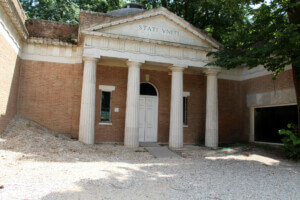Nothing much to report from yesterday, as it was a day of formal openings when very little was in fact open to the press or public. It was mostly a day of introductory speeches by biennale directors and city and government officials. Frank Gehry presented some models, made a few brief remarks, and then everyone headed for the hallway, where we had our first free prosecco and great little appetizers. Journalists and media types stood around asking about where the best parties were to be had in the coming days (more on this later).
Today—after two days of too many speeches and press conferences—the biennale finally opened the doors of both the Arsenale and the national pavilions in the giardini, and everyone had their first chance to officially see if people really do meet in architecture. I ran through the projects installed in the Arsenale and in the afternoon the Italian pavilion in the giardini, which is of course not the Italian pavilion but simply a large exhibition space. The gigantic Arsenale has only 15 installations this year, giving each vast amounts of space in which to confront visitors. Most are therefore huge installations and are really engaged in design pyrotechnics more than displays of building models. They are architecture, but in what is fast becoming a kind of biennale style, halfway between design and art.
These include a 3-D film by Wim Wenders of SANAA’s Rolex Center and a smoke-filled cloud room with a long spiral ramp that is a pale replica of Diller and Scofidio’s Blur Building from 2002. Another space titled Architecture as Air: Study for Chateau La Coste by the architect Junya Ishigami is constructed from a field of thin monofilament pieces precisely arrayed across the space like a barely visible Fred Sandback string sculpture. Ishigami’s piece is indecipherable and most visitors simply pass through, but I was told by some young workers that it was meant to be a self-supporting line house until a cat ran through last night and it came crashing down.
Can this be true? Anyway, it’s a good story. Like what happened yesterday to Aaron Betsky, who curated the biennale in 2008. He was turned back at the door because he did not have the right credentials. When he protested that he had been the curator two years ago, an official replied: “So what are you doing at the biennale this year?”
In the afternoon, I saw the Italian pavilion, which Italian curator Luca Molinari has filled with a more diverse body of work than displayed in the Arsenale, ranging from installation projects to artworks and models. It’s hard in a quick blog post to summarize the work in this enormous pavilion without flattening out the diversity here or reverting to clichés. It deserves more thought and attention and individual consideration and that’s what I will try and do in an upcoming post.
But if there is a theme in the Italian pavilion, it is that more than a few critique or try to update the notion of utopia either in its early idealization—or the more recent consideration of it as not a model worth considering. There is Tom Sachs’ installation of slightly torn paper Corbusian prototypes on the one side, and Aldo Cibic’s wonderful small-scale utopian landscape of idealized building types, from high-design, high-density housing to bland suburban cul de sacs. In between these are all sorts of architectural thoughts, but none more thoughtful than Rem Koolhaas and a history of his Office for Metropolitan Architecture, a tribute to his winning this year’s Golden Lion.
I did have a chance to check out the British pavilion and see its wonderful muf-designed wooden “medical school” theater and miniature Venetian estuary complete with crabs and snails. Both show the advantage of having designers of muf’s ability curating an exhibition. Finally, the Ryue Nishizawa-curated Japanese pavilion is also rethinking utopia, in this case a celebration of the 50th anniversary of the Metabolist movement. It brings back the movement but argues in fact that the city is organic and, as Aaron Levy claims, “beyond politics.”
Now for the important stuff: The best party so far was the Audi Urban Futures event at the fabulous and long-vacant Misericordia space, which a Venetian friend used as a basketball court when she was a child. The highlight of the party was the announcement that the Future Award (worth 100,000 euros) was won by Jurgen Mayer H., an architect of great design talent who is now beginning to emerge as an international force.
With the biennale finally underway, I’m beginning to wonder if Sejima is right, and people meet in architecture, or, as Italian critic Luigi Prestinenza Pugliese says, does this show prove that “architects don’t really like people?”










